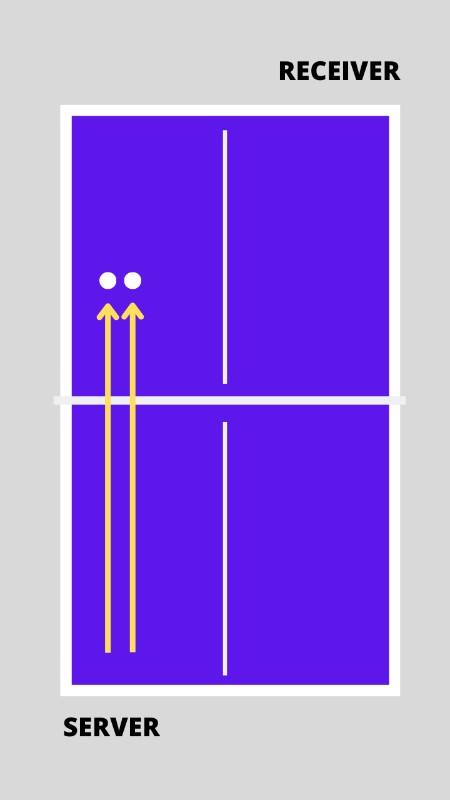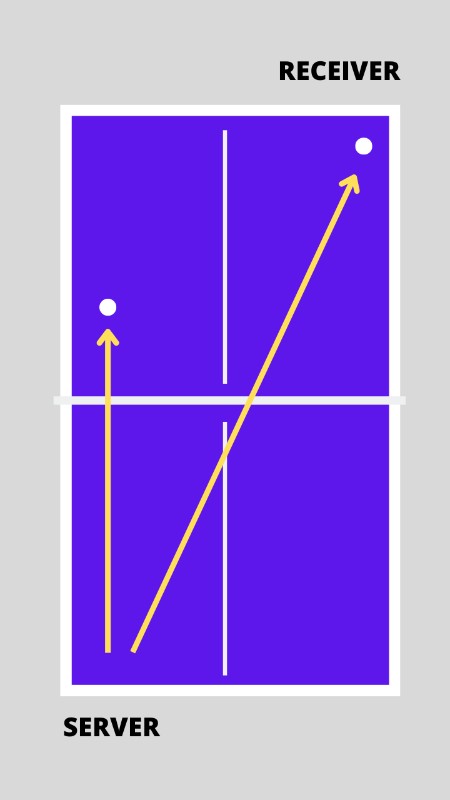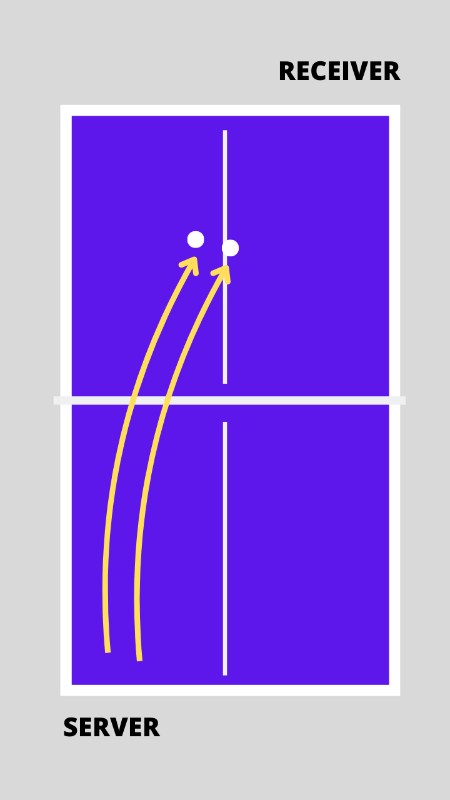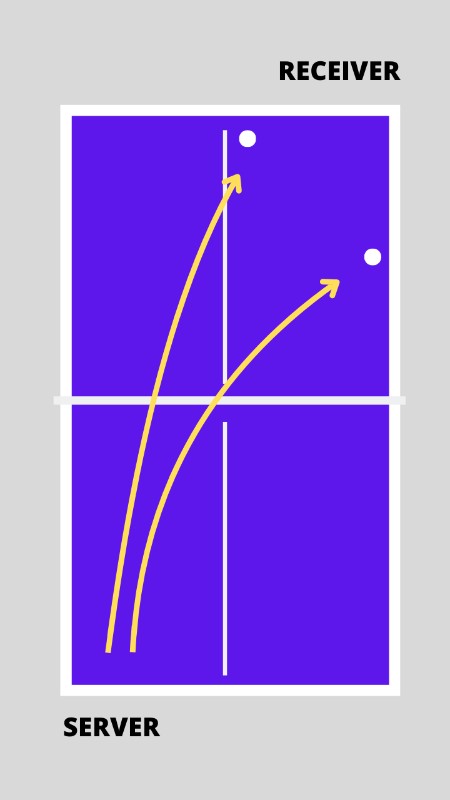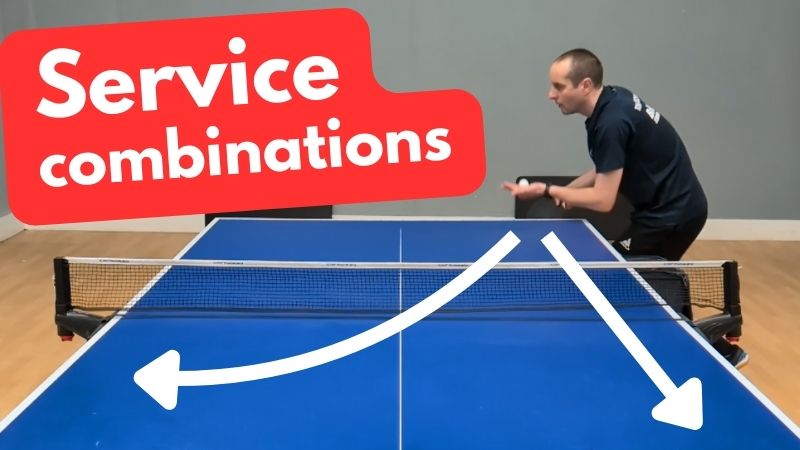
When serving in table tennis, we have many options available. We have all the different service actions – pendulum, backhand, hook, tomahawk, windscreen wiper. We have all the spin variations – backspin, sidespin, topspin, no spin. We have all the placement variations – short, wide, half-long, long.
So many options! But have you ever thought about how to pair your two serves? Which two serves combine particularly well together? I’m going to share four service combinations I like to use. You should try these out too. Or have a think about alternative service combinations. There are plenty of possibilities for you to try.
1. Backspin, no spin
This is one of the most common service combinations. You first serve heavy backspin, short or half-long. The goal is to get as much backspin as possible. Ideally you would force your opponent to return with a push. Even better, your opponent would push the ball into the net.
With your second serve, you use a very similar looking action, but don’t brush the ball. This will produce a ‘no spin’ serve. If your opponent fails to read this, and assumes it is another heavy backspin serve, he will push again, but this time the ball will pop up high, giving you an easy attacking opportunity.
I particularly like to do this combination short to a player’s forehand. Most players have a weaker forehand push, compared to their backhand push. So it’s possible to catch them out with both the heavy backspin (balls goes into the net) and then the ‘no spin’ (ball pops up). A very satisfying outcome.
2. Short to forehand, long to backhand
Again we start with a short backspin serve to the forehand. The goal here is to get the ball really quite short and close to the side of the table. Some players will find this placement hard to deal with. If they stretch too much, they are likely to make an error or play a weak shot. Other players will deal with this serve fine, but you are setting them up for the next serve.
The second serve goes very deep to the backhand. The more you can get it into the corner, the more effective it will be. Ideally this serve will also have a lot of pace, so sidespin or topspin is preferable. As the first serve was very short, some players then stay a little closer to the table to protect against another short serve. This makes them more vulnerable to the very deep serve.
There is also a nice contrast in speed and spin. The first serve is slower with backspin. The second serve is much faster, with sidespin or topspin. For players who don’t move well, it’s possible to catch them out with both serves.
3. Side-back, side-top
With this combination you are testing your opponent’s ability to read spin. You start with a sidespin-backspin serve. I like to do this with a pendulum service action, but you can use any action you like. Then with a very similar action, the second serve should be sidespin-topspin. If your opponent fails to read the change of spin, then he will make an error or play a weak return.
I like to serve this combination, half-long into the centre of the table. The reason for this is that my opponent has to make a decision about returning with his backhand or forehand. By giving him this decision to make, it sometimes distracts from reading the spin. In essence I am giving his brain two problems to solve – deciding whether to play forehand or backhand and reading the spin.
As the match progresses, you can play around with the order. Maybe you start with sidespin-topspin and then do sidespin-backspin. Or occasionally you may do the same spin twice, just to keep them guessing.
4. Wide to backhand, long to crossover
I often have a lot of success serving long to a player’s crossover position (e.g. the right hip on a right handed player). But to set this up, I first serve to the wide backhand position. Some players struggle to reach this ball at all. Hooray, cheap point. But it also has the impact of bringing a player closer to the table again in preparation for another wide serve.
Now with the second serve, I go long to the crossover. If the player is a little too close to the table, it is very hard to deal with this serve. The player has very little space, or time to adjust and often makes an error.
I typically serve sidespin-backspin very wide and sidespin-topspin to the crossover. But you can play around with the spin. It could be sidespin-topspin wide and sidespin-backspin to the crossover. Or use the same spin twice. Really it is the change of placement which does most of the damage.
Develop your own service combinations
These are just a few ideas you can try out. But really you should come up with your own service combinations which suit your style of play.
They might be the same as mine. Or they might be completely different. It doesn’t matter. Just developing some options – any options – means you are thinking about your service game more strategically.
You have two serves. You are in charge. What damage can you do? Plan out some options, then experiment and practise. When it starts working, your service game will become much stronger.
Want more service tips?
If you want more service tips, I recommend you join Tom’s TT Academy. You will also get access to a wide range of coaching content, including:
- in-depth courses
- training drills
- session plans
- video analysis
- fitness videos
- robot training videos
- member discussions
- skill challenges
- and lot’s more!
You can access all this content for less than £1 per week. New content is added regularly. Join hundreds of table tennis players around the world today at tomsttacademy.com

